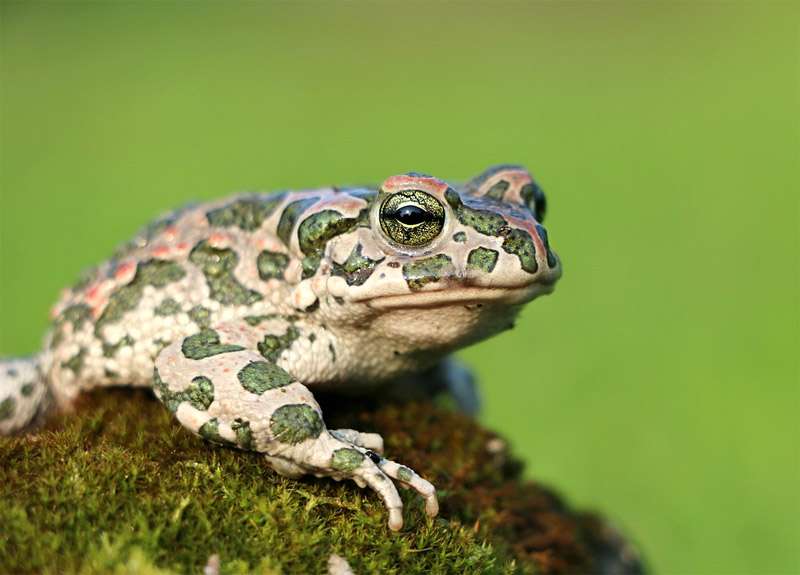
What a heart in amphibians: detailed description and characteristics
Amphibians belong to the class of four-legged vertebrates, in total this class includes about six thousand seven hundred species of animals, including frogs, salamanders and newts. This class is considered small. There are twenty-eight species in Russia and two hundred and forty-seven species in Madagascar.
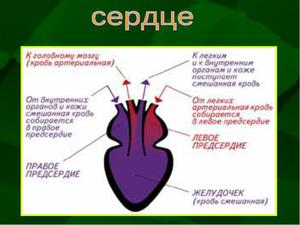
Amphibians are terrestrial primitive vertebrates, they occupy an intermediate position between aquatic vertebrates and terrestrial, because most species reproduce and develop in the aquatic environment, and individuals, adults begin to live on land.
Amphibians have lungs, which they breathe, blood circulation consists of two circles, and the heart is three-chambered. Blood in amphibians is divided into venous and arterial. Amphibians move with the help of five-limbed limbs, and they have spherical joints. The spine and the skull are articulated movably. The palatal-square cartilage grows from the autostyle, and the gimandibular becomes the auditory ossicle. Hearing in amphibians is more perfect than, in fish: in addition to the inner ear there is a middle one. The eyes have adapted to see well at different distances.
On land, amphibians are not fully adapted to life - this can be seen in all organs. The temperature of amphibians depends on it, what is the humidity and temperature of the environment. Their ability to navigate and move by land is limited.
Circulation and circulatory system
Amphibians have a three-chambered heart, it consists of a ventricle and an atrium in number of two pieces. In tailed and legless right and left atria are fully separated. The tailless have a complete septum between the atria, however, amphibians have one common hole, which connects the ventricle to both atria. exept this, in the heart of amphibians there is a venous sinus, which takes venous blood and communicates with the right atrium. The arterial cone is adjacent to the heart, blood pours out of his ventricle.
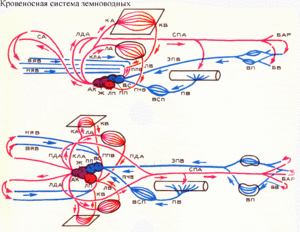
The arterial cone has a helical valve, which distributes blood in three pairs of vessels. The heart index is the ratio of heart mass to body weight percentage, it depends, how active the animal is. Example, the grass and green frog move very little and the heart rate is less than half a percent. And in the active, ground frogs almost one percent.
In amphibian larvae, the circulation has one circle, their blood supply is similar to fish: one atrium in the heart and ventricle, there is an arterial cone, branches out 4 pairs of gill arteries. The first three arteries break down into capillaries in the outer and inner gills, and gill capillaries merge in gill arteries. Artery, endure the first gill arch, breaks down into carotid arteries, which supply the head with blood.
Gill arteries
There is a merger of the second and third gill arteries with the right and left roots of the aorta and their connection in the dorsal aorta. The last pair of gill arteries does not break down into capillaries, because on the fourth arch on the inner and outer gills, there is a confluence in the root of the aorta of the back. The development and formation of the lungs is accompanied by blood changes.
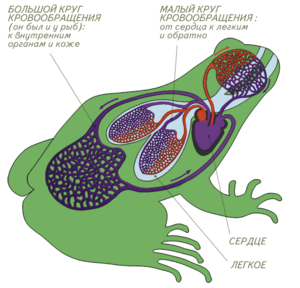
The atrium is divided by a longitudinal partition on the left and right, making a three-chambered heart. The network of capillaries is reduced and turns into carotid arteries, and the roots of the dorsal aorta originate in the second pair, in tails there is a preservation of the third pair, the fourth pair turns into a cutaneous-pulmonary artery. The circulatory system will also be transformed and becomes intermediate between the terrestrial scheme and the water. The greatest restructuring occurs in amphibian amphibians.
Adult amphibians have a three-chambered heart: one ventricle and atrium in the amount of two pieces. The venous thin-walled sinus is adjacent to the atrium on the right side, and the arterial cone departs from the ventricle. It is possible to draw a conclusion, that the heart has five divisions. There is a common hole, due to which there is an opening in a ventricle of both auricles. There are also atro-ventricular valves, they prevent blood from entering the atria, when there is a contraction of the ventricle.
A number of cameras are being formed, which communicate with each other due to muscular outgrowths of ventricular walls - it does not allow blood to mix. An arterial cone departs from the right ventricle, and a spiral cone is located inside it. From this cone begin to depart arterial arches in the amount of three pairs, first the vessels have a common shell.
The right and left cutaneous-pulmonary arteries depart from the cone first. Then the aortic roots begin to recede. Two gill arches separate the two arteries: subclavian and occipital-vertebral, they supply blood to the forelimbs and muscles of the torso, and merge into the dorsal aorta under the spine. The dorsal aorta separates the intestinal mesenteric artery (this artery supplies blood to the digestive tract). As for other branches, then blood through the spinal aorta to the hind limbs and to other organs.
Carotid arteries
The carotid arteries last depart from the arterial cone and break down into internal and external arteries. Venous blood from the hind limbs and body, located behind the going sciatic and femoral veins, which merge into the portal renal veins and break down into capillaries in the kidneys, that is, the renal portal system is formed. From the left and right femoral veins veins depart and merge into an odd abdominal vein, which goes to the liver along the abdominal wall, this is how it disintegrates into capillaries.
The portal vein of the liver collects blood from the veins of all parts of the stomach and intestines, in the liver it breaks down into capillaries. There is a merger of renal capillaries into veins, which are enduring and flowing into the posterior odd vena cava, veins also flow there, departing from the gonads. The posterior vena cava passes through the liver, however, no blood enters the liver, which it contains, small veins from the liver flow into it, and she, in turn, flows into the venous sinus. All tailed amphibians and some tailless ones retain cardinal posterior veins, confluence of which occurs in the vena cava.
Arterial blood, which is oxidized in the skin going into the great cutaneous vein, and cutaneous vein, in turn, carries venous blood enters the subclavian vein directly from the brachial vein. There is a fusion of subclavian veins with internal and external jugular veins in the left into the vena cava, which flow into the venous sinus. Blood from there begins to enter the atria on the right. Arterial blood collects from the lungs in the pulmonary veins, and the veins flow into the atria on the left side.
Arterial blood and atria
When breathing is pulmonary, mixing blood begins to collect in the atrium of the right side: it consists of venous and arterial blood, venous comes from all departments through the vena cava, and arterial comes through the veins of the skin. Arterial blood fills the atria on the left side, blood comes from the lungs. When there is a simultaneous contraction of the atria, then blood enters the ventricle, the growths of the stomach walls do not allow the blood to mix: venous blood predominates in the right ventricle, and in the left arterial.
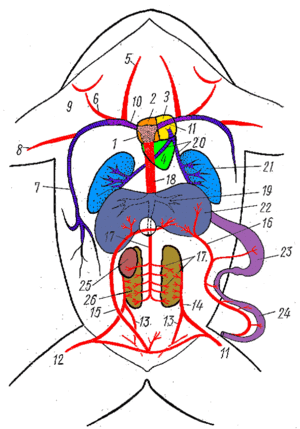
The arterial cone departs from a ventricle of the right party, therefore, when the ventricle contracts, the venous blood first enters the cone, which fills the cutaneous pulmonary arteries. If the ventricle continues to contract in the arterial cone, the pressure begins to increase, spiral valve begins to move and opens the openings of the aortic arches, in them the mixing of blood is directed from the center of the ventricle. At full reduction of a ventricle arterial blood from the left half gets to a cone.
It will not be able to pass into the arch aortas and pulmonary cutaneous arteries, because they already have blood, which with strong pressure shifts the spiral valve, opening the mouth of the carotid arteries, arterial blood will flow there, which will go to the head. If pulmonary respiration is switched off for a long time, example, during the winter under water, more venous blood enters the head.
Oxygen enters the brain in smaller quantities, because there is a general decrease in metabolism and the animal falls into a stupor. In amphibians, relating to the caudate often there is an opening between the two atria, and the helical valve of an arterial cone is poorly developed. Accordingly, the arterial arches receive the most mixing blood, than in tailless amphibians.
Though, that in amphibians blood circulation follows two circles, due to that, that ventricle one, it does not allow them to be completely separated. The structure of such a system is directly related to the respiratory system, which have a dual structure and correspond to the way of life, led by amphibians. This makes it possible to live like on land, and spend a lot of time in the water.
Red bone marrow
The red marrow of the tubular bones begins to appear in amphibians. The amount of total blood is up to seven percent of the total weight of the amphibian, and hemoglobin varies from two to ten percent or up to five grams per kilogram of body weight, the capacity of oxygen in the blood varies from two and a half to thirteen percent, these figures are higher than in fish.
Amphibians have large erythrocytes, however, there are few of them: from twenty to seven hundred and thirty thousand per cubic millimeter of blood. The rate of larval blood is lower, than in adults. In amphibians as well as in fish, blood sugar levels vary depending on the season. Shows higher values in fish, and in amphibians tailed from ten to sixty percent, while in the tailless from forty to eighty percent.
When summer ends, there is a strong increase in carbohydrates in the blood, timely preparation for winter, because carbohydrates accumulate in the muscles and liver, as well as in the spring, when the period of reproduction comes and carbohydrates enter the blood. In amphibians there is a mechanism of hormonal regulation of carbohydrate metabolism, although it is imperfect.
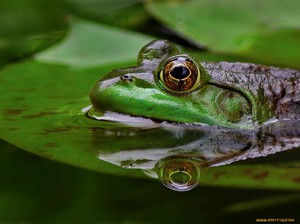
Three detachments of amphibians
Amphibians are divided into such groups:
Amphibians tailless. This unit contains about one thousand eight hundred species, who have adapted and move by land, jumping on the hind limbs, which are elongated. This detachment includes frogs, frogs, zherlyanki and the like. Tailless is on all continents, the exception is ??only Antarctica. These include: frogs are real, quacks, circular, frogs are real, rhinoderma, whistlers and garlic makers.
- Amphibians tailed. They are the most primitive. There are about two hundred and eighty species. These include all sorts of newts and salamanders, they live in the northern hemisphere. This includes the Proteus family, salamanders helpless, salamanders are real and angular teeth.
- Amphibians are legless. There are about fifty-five thousand species, most of them live underground. These amphibians are quite old, which have survived to our time due to that, who managed to adapt to the digging way of life.
Amphibian arteries are of the following types:
- Carotid arteries - supply the head with arterial blood.
- Pulmonary arteries - to the skin and lungs carry venous blood.
- The aortic arches carry blood, which is mixed with other organs.
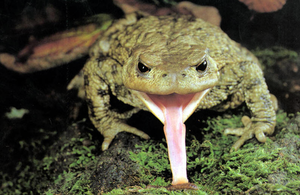
Amphibians are predators, salivary glands, which well-developed their secret moisturizes:
language
- food and mouth.
Amphibians originated in the Middle or Lower Devonian, that is, about three hundred million years ago. Fish are their ancestors, they have light and have paired fins of which, it is possible, and five-limbed limbs were developed. Fish ancient kisteperie just meet these requirements. They have lungs, and in the skeleton of the fins clearly visible elements similar to parts of the skeleton of the five-toed terrestrial limb. Also on that, that amphibians are descended from ancient crested feathers indicates a strong similarity of the integumentary bones of the skull, similar to the skulls of amphibians of the Paleozoic period.
The lower and upper ribs were also present in kisteperi and amphibians. However, dioecious fish, in which the lungs were very different from amphibians. So, features of movement and respiration, which provided the opportunity to go ashore in the ancestors of amphibians appeared when they were just aquatic vertebrates.
The reason, which led to the emergence of these devices, was, apparently, peculiar regime of freshwater reservoirs, in them lived some species of kisteperyh fish. This could be periodic drying or lack of oxygen. The most leading biological factor, which became decisive in the break of the ancestors with the reservoir and their consolidation on land - this is a new food, which they found in their new habitat.
Respiratory organs in amphibians
Amphibians have the following respiratory organs:
The lungs are the respiratory organs.
- Gills. Present in tadpoles and some other inhabitants of the water element.
- Organs of additional respiration in the form of skin and mucous lining of the oropharynx.
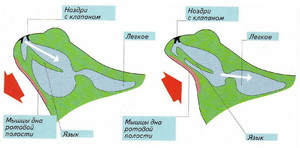
In amphibians the lungs are represented in the form of paired sacs, empty inside. They have walls, very thin in thickness, and inside there is a poorly developed structure of cells. However, amphibians still have small lungs. Example, in frogs, the ratio of lung surface to skin is measured by a ratio of two to three, compared with mammals, in which this ratio is fifty, and sometimes a hundred times more in favor of the lungs.
With the transformation of the respiratory system in amphibians there is a change in the respiratory mechanism. Amphibians still have a fairly primitive type of forced respiration. Air is collected in the oral cavity, for this purpose nostrils open and the bottom of an oral cavity goes down. Then the nostrils are closed with valves, and the bottom of the mouth rises due to which air enters the lungs.
How the nervous system is arranged in amphibians
In amphibians, the brain weighs more than in fish. If you take the percentage of brain weight and mass, then in modern fish, having cartilage figure will 0,06-0,44%, in bony fish 0,02-0,94%, in amphibians tailed 0,29-0,36 %, in amphibians tailless 0,50-0,73%.
The forebrain of amphibians is more developed than that of fish, there was a complete division into two hemispheres. Development is also expressed in the content of more nerve cells.
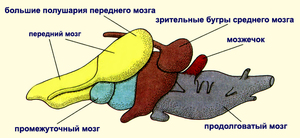
The brain is made up of five parts:
Relatively large forebrain, which is divided into two hemispheres and there are olfactory particles.
- Well-developed midbrain.
- Underdeveloped cerebellum. This is due to the fact, that the movement of amphibians is monotonous and uncomplicated.
- The center of the bloodstream, The digestive and respiratory systems are the medulla oblongata.
- Vision and bone tone are controlled by the midbrain.
Lifestyle, led by amphibians
Lifestyle, conducted by amphibians, directly related to their physiology and structure. Respiratory organs are imperfect in structure - this applies to the lungs primarily because of this imprint on other organ systems. Moisture constantly evaporates from the skin, which makes amphibians dependent on the presence of moisture in the environment. Ambient temperature, in which amphibians live is also very important, because they do not have warm-bloodedness.
Representatives of this class have a different way of life, so there is a difference in structure. The diversity and abundance of amphibians is especially great in the tropics, where there is high humidity and almost always high air temperature.
The closer to the pole, the fewer species of amphibians become. There are very few amphibians in the dry and cold regions of the planet. There are no amphibians there, where there are no reservoirs, even temporary, because eggs can often develop only in water. There are no amphibians in salt water, their skin does not maintain osmotic pressure and hypertensive environment.
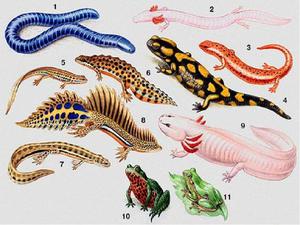
Eggs do not develop in salt water bodies. Amphibians are divided into the following groups according to the nature of habitat:
water,
- terrestrial.
Terrestrial can go far from water bodies, unless it is a breeding season. But water, vice versa, spend their whole lives in the water or very close to the water. Tailed forms are dominated by aquatic forms, some species of tailless may also belong to them, in Russia, example, these are pond or lake frogs.
Tree amphibians are widespread among terrestrial ones, example, wedding frogs and quacks. Some terrestrial amphibians dig a way of life, example, some tailless, and legless almost all. In terrestrial inhabitants, usually, better developed lungs, and the skin is less involved in the respiratory process. Due to this, they are less dependent on humidity, in which they live.
Amphibians are engaged in useful activities, which varies from year to year, it depends on their number. It is different at certain stages, at a certain time and under certain weather conditions. Amphibians kill insects more than birds, having a bad taste and smell, as well as insects, with indulgent coloring. When almost all insectivorous birds are asleep, amphibians hunt.
To you, that amphibians are of great benefit as insect exterminators in gardens and orchards have long attracted the attention of scientists. Dutch gardeners, Hungary and England specially brought frogs from different countries, releasing them in greenhouses and gardens. In the mid-1930s, about one hundred and fifty species of agha frogs were exported from the Antilles and Hawaii.. They began to reproduce and released more than a million frogs on the sugar cane plantation, the results exceeded all expectations.
Sight and hearing of amphibians
Amphibian eyes protect the lower and upper eyelids from clogging and drying, as well as the ciliary membrane. The cornea became convex, and the lens is lenticular. Mostly amphibians see objects, moving.
As for the hearing organs, then the auditory ossicle and the middle ear appeared. This phenomenon is caused by them, that there was a need to better perceive sound vibrations, because the air environment has a higher density, than water.




